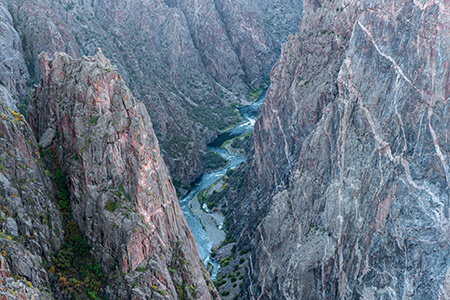This is a lesson summary. The full lesson can be viewed by purchasing an online course subscription.
Learning Objective
In this lesson we will learn about the formation of metamorphic rocks. We will also look at some common metamorphic rocks and discuss their properties and uses.
Learning Outcomes
By the end of this lesson you will be able to:
- Explain what metamorphic rocks are and describe how they are formed.
- Describe the processes of recrystallisation and foliation.
- Discuss factors that affect metamorphism, such as heat and pressure.
- Describe the different types of metamorphism and the settings in which they occur.
- Describe some common foliated and non-foliated metamorphic rocks.
- Discuss some common uses of metamorphic rocks.

(Image: Danita Delimont, Adobe Stock)
Lesson Summary
- Metamorphic rocks are formed when pre-existing rocks undergo a transformation (metamorphism) as a result of being subjected to high pressure and temperature.
- Metamorphic rocks can form from igneous rocks, sedimentary rocks or other types of metamorphic rocks.
- Metamorphism involves recrystallisation – a rearrangement of atoms within minerals which is often associated with an increase in crystal size.
- Metamorphism may also involve foliation – a flattening and realignment of crystals as a result of directed pressure, resulting in rocks with a layered or banded appearance.
- Metamorphism results in rocks with different physical properties, but similar chemical properties, to the rocks from which they formed.
- The main factors that determine the changes associated with metamorphism are heat, pressure, presence of fluids, composition of the parent rock and time.
- Sources of heat include Earth’s internal heat, magma, lava, hot fluids and friction.
- Sources of pressure include overlying rocks and sediment, collisions between tectonic plates and movement along fault lines.
- There are several types of metamorphism, including:
- Burial metamorphism – formation of metamorphic rock from deeply buried rock.
- Regional metamorphism – formation of metamorphic rock when tectonic plates collide.
- Dynamic (cataclastic) metamorphism – formation of metamorphic rock when large masses of rock slide past each other along fault lines.
- Contact metamorphism – formation of metamorphic rock when rock comes into contact with magma or lava.
- Hydrothermal metamorphism – formation of metamorphic rock when superheated fluids penetrate rock.
- Metamorphic rocks are usually harder than sedimentary rocks and at least as hard as igneous rocks.
- Metamorphic rocks are divided into two main categories – foliated and non-foliated rocks.
- Foliated metamorphic rocks have a layered or banded appearance as they are composed of crystals that are elongated and aligned in the same direction.
- Examples of foliated metamorphic rocks include slate, phyllite, schist and gneiss, which demonstrate progressive grades of metamorphism.
- Non-foliated metamorphic rocks do not have a layered or banded appearance as they are composed of crystals that are not elongated or aligned in any particular direction.
- Examples of non-foliated metamorphic rocks include quartzite, marble and hornfels, which all form as a result of contact metamorphism of sedimentary rocks.
- Metamorphic rocks are mainly used as building materials due to their hardness and strength.

(Image: PxHere)
(Header image: Keith Wheatley, Adobe Stock)
